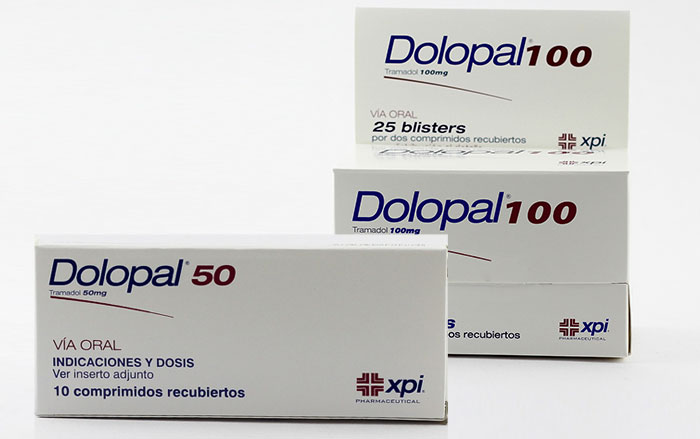[vc_row inner_container=»true» bg_color=»#ffffff» style=»margin-bottom:0px; padding-bottom:0px;»][vc_column alignment=»left» width=»1/2″]
Dolopal
[/vc_column][vc_column width=»1/2″] [/vc_column][/vc_row][vc_row inner_container=»true» bg_color=»#ffffff» style=»margin-top:0px; margin-bottom:0px;»][vc_column width=»1/1″]
[/vc_column][/vc_row][vc_row inner_container=»true» bg_color=»#ffffff» style=»margin-top:0px; margin-bottom:0px;»][vc_column width=»1/1″]Properties
Dolopal contains Tramadol, a centrally acting pain reliever, opioid agonist especially on «mu» receptors. Tramadol also has a modulating action on the monoaminergic system, since it causes an inhibition of the reuptake of norepinephrine and serotonin in the CNS, increasing its bioavailability at the synapse, which results in analgesia. These two mechanisms of action are synergistic with each other.
Dolopal does not depress respiratory function at therapeutic doses, nor does it affect gastrointestinal motility and its effects on the cardiovascular system are slight.
Dolopal absorption is almost complete after oral administration and is not affected by food intake; for this reason its bioavailability is 90%. The volume of distribution is 2.6 to 2.9 liters per kg of weight and is linked to plasma proteins by 20%. It is metabolized in the liver by demethylation, glucuronization and sulfation. Its main active metabolite is – O – desmethyltramadol (MI) and its formation depends on cytochrome P450 (CYP 2D6).
The half-life of Dolopal is approximately 4-6 hours, and can be increased to 7 hours by the administration of multiple doses and in patients older than 75 years. The half-life of your metabolite (MI) is 7.4 hours. Its maximum plasma concentration reaches it in 2 hours. It is eliminated via the kidneys: 30% without alterations and 60% as metabolites. 7% of the dose is removed by hemodialysis. Tramadol crosses the placenta and has been shown to cross the blood-brain barrier in rats and possibly humans as well.
In patients with renal clearance less than 30 ml per minute, the dose should be adjusted, the same indication being established for cirrhotic patients and people over 75 years of age.
Indications
Dolopal is indicated for the treatment of moderate to severe pain, of acute or chronic origin (fractures, dislocations, acute myocardial infarction, cancer, etc.). It can also be used as a preoperative analgesic, as a complement to surgical anesthesia, in the postoperative period, as well as in painful diagnostic and therapeutic interventions and pain during labor.
[/vc_column][/vc_row][vc_row inner_container=»true» bg_color=»#ffffff» style=»margin-top:0px; margin-bottom:0px;»][vc_column width=»1/2″]
Contraindications
Dolopal should not be administered in case of alcohol, sleeping pills, pain relievers and psychotropic drugs. It should be used with caution in patients with increased reactions to opioids, patients with head trauma, shock, reduced or undetermined level of consciousness, disorders of the center or respiratory function, or increased intracranial pressure.
Side effects
After administration of Dolopal, sweating, dizziness, nausea, vomiting, dry mouth, tiredness and clouding may appear.
Alterations in cardiovascular regulation (eg, palpitations, postural hypotension, or cardiovascular collapse) have been rarely observed.
Drug interactions
When Dolopal is used simultaneously with other centrally acting medicinal products, an increase in the depressant effect is possible. However, a favorable effect on pain sensation is to be expected by combining Dolopal with, for example, a tranquilizer. Dolopal should not be administered to patients treated with MAO inhibitors.
Cautions
In accordance with current recommendations on pregnancy, Dolopal should only be administered during pregnancy under precise indications. Dolopal can be used during childbirth. Regarding its use during lactation, it should be noted that approximately only 0.1% of the administered dose passes into breast milk. In patients with hypersensitivity to other centrally acting analgesics it should be administered with due precautions.
The patient should be informed that his ability to drive vehicles and to operate machinery may be impaired. This is especially applicable in combination with the intake of alcohol or another psychotropic substance.
During long-term use, tolerance and mental and physical dependence may develop.
Warnings
Keep out of reach of children. Sale by prescription.
[/vc_column][vc_column width=»1/2″ style=»background-color:#f4f4f4; height:100%; padding-left:10px; padding-right:10px;»]
Composition
Coated tablet
Dolopal 50:
Tramadol Hydrochloride 50mg
C.S.P. excipients 1 coated tablet
Dolopal 100:
Tramadol Hydrochloride 100 mg
C.S.P. excipients 1 coated tablet
Posology and administration
The dose of Dolopal must be adjusted according to the intensity of the pain and the sensitivity of each patient. The dose of Dolopal in adults and young people over 14 years of age is as follows:
Orally:
50 – 100 mg equivalent with 1 – 2 tablets, every 8-12 hours.
In low-weight adults, 1 – 1.5 mg / kg of weight can be used per dose (up to 4 a day).
Daily doses of 400 mg are generally sufficient for the treatment of cancer pain and severe postoperative pain, however, higher daily doses may also be administered.
Dolopal can be administered with or without food, with a little liquid or on a sugar cube.
The prolonged use of Dolopal can develop addiction, so the doctor must decide the duration of the treatment and eventually the introduction of breaks during it.
Presentation
Dolopal 50: box containing 10 and 50 coated tablets
Dolopal 100: box containing 10 and 50 coated tablets.
Storage Recommendations
Store at a temperature below 30 °C.
[/vc_column][/vc_row]
